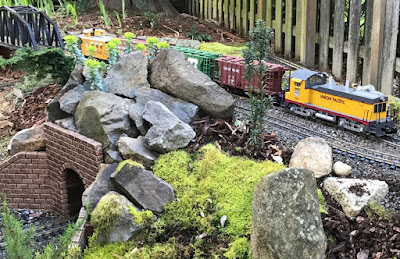Sometimes when I'm on vacation I will seek out railroads. Other times the railroads tend to find me without any effort on my part. This week I rode behind two steam locomotives, used three monorails, two people mover systems and a cable car, and I came across a beautiful garden railroad as well. Where else could I be other than Orlando?
The Walt Disney World Railroad circles the Magic Kingdom on a three-foot narrow-gauge track. The railroad owns four restored steam locomotives and most days two of those will be in operation, hauling over 3.7 million passenger a year!
 |
| WDWRR #3, the Roger E. Broggie, is a 4-6-0 "ten-wheeler" originally built by Baldwin in 1925. |
 |
| WDWRR #4, the Roy O. Disney, is a 4-4-0 "American" originally built by Baldwin in 1916. |
 |
| Turn out for the siding to the train barn. |
 |
| Main Street Station |
One of my favorite rides at Disney World is the Tomorrowland Transit Authority PeopleMover. This ride uses open-air cars; enclosed cars aren't necessary as the entire track is covered. Car sets ride on steel rails, and are propelled using linear synchronous motors centered between the two tracks.
 |
| View of the tracks from a lead car showing the embedded linear synchronous motors space about 8–10 feet apart. |
 |
| Approaching the station. |
 |
| Covered track headed toward Space Mountain. |
Getting to, from and between the Magic Kingdom and Epcot is best done using the Walt Disney World Monorail System, which I used three times while I was there.
 |
| Of the 12 trains in service, the green was my favorite. |
 |
| The red train. |
A complete surprise for me was the
Epcot Garden Railway, a 50 x 130 foot LGB layout depicting a Bavarian mountainside and village. It includes a stream and multiple bridges, but the most impressive feature was the extensive forest of very well maintained and pruned trees. The garden train is appropriately located in the Germany area of Epcot.
 |
| A passenger train passes by the village. |
 |
| A freight train passing a gap between two tunnels in the mountainside. |
And over at Universal Studios a featured attraction is the Hogwarts Express Train that connects the two parks. I wasn't aware beforehand that it's actually a cable car, which was a delightful surprise. There are two trains in operation and a replica of a steam locomotive leads (or trails, depending on your direction) each set of cars. The replica locomotives are modeled after a preserved
Great Western Railway locomotive, 5972 Olton Hall, which was used in the Harry Potter movies. Only one side of the train faces visitors, which has been decorated to recreate the original 5972 as closely as possible.
The two trains operate on a single track with a passing track halfway between the two stations, allowing two trains to operate in the style of a funicular. I'm not sure if the rope reverses direction for each trip like a funicular does, or if it runs continuously in one direction like a cable car with the grips switching ropes for each trip. Given the smoothness of the start up I think it's probably the former case, but I should have been paying more attention!
 |
| The locomotive has drivers only on the side facing visitors. The weight of the train is supported not on the drivers but on two smaller trucks mostly hidden from view. The drivers move when the train is in motion and appear to be propelling the train, but they are actually gliding above a decorative outer track—they don't make contact in order to reduce friction. |
 |
| View from in front of the locomotive showing the haul rope and counter rope, and the decorative outer track facing the viewer. |
 |
| A close up view of one of the trucks underneath the tender. If you enlarge this picture you will see the outer false wheels are floating above the track, which is very rusty as none of the wheels are making contact to wear off the rust. Behind the false outer wheels is a smaller truck supporting the weight of the vehicle on the inner tracks, which are smooth and shiny from use. |
Finally, a visit to Orlando wouldn't be complete without a trip on the Automated People Movers at the Orlando International Airport. The current trains are near end-of-life and about to be replaced during a makeover costing nearly a billion dollars. I've read that some of the trains have already been replaced, but the ones I saw were the old ones.
 |
| The APM uses rubber tires that run along two parallel concrete tracks. A center steel rail provides guidance and power. |
 |
| This APM train likely has only a few more months of service before retirement. |




























